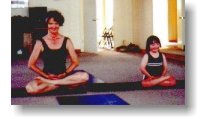The Yoga Experience for People with Developmental Disabilities… By Mary Bryant, WARC
Yoga has many well-known benefits for all of us. Increased flexibility and stamina, decreased stress and anxiety and improved mental health are just a few. Imagine how useful these benefits are for people with developmental disabilities.
The people at WARC have seen first hand the benefits of Yoga. WARC works with people with developmental disabilities in a variety of work settings. In early 2000, WARC received a healthy Communities Grant from the Nevada Public Health Foundation to provide Yoga Classes to interested people at WARC.
The problem that the grant money was to address was that adults with mental retardation usually lead sedentary lifestyles and have a high stress factor, both of which put them at risk for heart disease.
Our goal was to create a more physically active lifestyle and decrease stress by:
- Creativing an interest in physical/emotional well being
- Providing a physical activity that is enjoyable and is tailored to each individual’s needs and abilites
- Providing a means to handle stress in daily life
- Providing training that can easily be integrated into daily life.
Now one year later, we are thrilled with the results of the program. At the beginning of the program, we had 2-5 people attending the weekly class. Through word of mouth, the interest has expanded and we currently se 12-15 people attending each class.. Because of the size and special needs of our group we now have two certified Yoga Instructors, Kathy Randolph and Holly Laughton, co-teaching each class.
Yoga has taught the students to stretch and lengthen the muscles and helped to rebalance both body and mind. The breathing techniques taught in yoga have produced a calming effect on the mind and body and can be practiced anywhere and any time. We have completed surveys with the participants, their work supervisors and the Yoga instructors. Without exception , the people who routinely participated in the yoga class reported improved flexibility and balance, reduced stress, and increased calmness. In addition, there were some startling improvements:
- John, who has a traumatic brain injury and uses a wheelchair, no longer uses his wheelchair for yoga class and is now doing the standing poses by himself. He now also participates in a martial arts class.
- Amanda, whose mother feared she would not understand the concepts or be able to participate, is now doing all the poses unassisted.
- Ramin takes the bus to The Yoga Center for additional classes.
- Wayne, who has always been thought to be quite uncommunicative, is making jokes (at the expense of the yoga instructors) that everyone enjoys and participates fully in the class.
- Sharon has become more flexible and active as she gets some relief from her arthritis.
Another significant benefit has been the improvement in the self-esteem of the yoga students. For many of them, yoga is an activity at which they are successful. Each person works at his/her own rate. This creates tremendous pride and sense of accomplishment to people who others have not seen as particularly capable in the past.
On a personal note, yoga has been a “ticket” for my daughter, Kailin, to friendship and respect. Kailin is six years old and has Down Syndrome. She has been taking yoga classes from Kathy Randolph at The Yoga Center since she was four years old. She was able to be very successful at yoga poses from the beginning, thanks in part to the low joint tone that is part of Down Syndrome. Because of her success, she practices yoga often, which has improved her muscle and joint tone and increased her stamina. Another benefit has been the increase in her attention span, especially when doing yoga. She often does yoga poses for 30-40 minutes without losing concentration and has even participated in 30 minute meditation sessions after yoga.
Because of her interest and ability, Kailin’s teacher believes that Kailin could have a career as a yoga teacher if she keeps up her practice. Of coarse, it’s a bit embarrassing when my yoga stance is critiqued and corrected by my six-year old!
Most important to me has been how Kailin’s involvement in yoga has made her part of the community. At her kindergarten and pre-school, Kailin is fully included with typical children. To them she is not the “kid with the disability”, she is the “Yoga Kid”. I’ve been told that during free time, she sometimes has up to 10 kids sitting in a circle for impromptu yoga classes that last about 20 minutes. The children gather around her and follow her instruction. And now she is an official “teaching assistant” for Kathy Randolph, who teaches a weekly class to all of the children at Kailin’s pre-school.
So, besides the health benefits, yoga has opened the doors for Kailin and other people with developmental disabilities to be successful, gain respect, make friends and even expose them to not-traditional career options!
